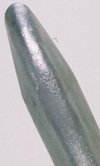A question of lead
 In 1949, British industrialist Tony Vandervell bought a contemporary Ferrari Grand Prix car - not a straightforward exercise in the aftermath of World War II, as it required an import licence, while the export of currency to Italy required special permission. Vandervell argued to the British powers that be that he needed the car as a test bed for his innovative Thinwall bearings. For its part, Ferrari appreciated the significance of those bearings, even if getting hold of them meant putting a Grand Prix car into the hands of a private entrant - and a British one at that.
In 1949, British industrialist Tony Vandervell bought a contemporary Ferrari Grand Prix car - not a straightforward exercise in the aftermath of World War II, as it required an import licence, while the export of currency to Italy required special permission. Vandervell argued to the British powers that be that he needed the car as a test bed for his innovative Thinwall bearings. For its part, Ferrari appreciated the significance of those bearings, even if getting hold of them meant putting a Grand Prix car into the hands of a private entrant - and a British one at that.
In fact, the thin-wall shell-type crankshaft bearing had originated in the US in the 1920s as a replacement for the earlier thick-wall/poured-in-place type, which had consisted entirely of lead-based white metal. Although white metal offers first-rate bearing properties, its fatigue strength is poor. The thin-wall alternative consisted of a thin steel backing with a thin white-metal lining. This composite offered superior fatigue strength with another advantage - superior precision in manufacture.
Vandervell bought a licence to manufacture the patented thin-wall bearings for the UK and European markets. He was soon improving them, and Ferrari was an early convert in the racing world. These days the company established by Vandervell in the UK still supplies bearings to race engine constructors, although it's now under the ownership of the MAHLE Group. Its high-end race bearings are known as V-series in recognition of where, within that global organisation, they are still made.
The tradition started by Vandervell in 1949 extends these days not only to Formula One but also to the likes of Le Mans, NASCAR and the NHRA. V-series bearings are widely used in these series, and these days they are 'tri-metal' productions, indicating that they are a composite of three rather than two layers. But what hasn't changed is the use of lead alloys in the inner two layers.
This is perhaps surprising, given the trend in the automotive industry to eliminate lead from all engine components. This trend is being widely encouraged by governments - indeed, the EU has now decreed that automotive bearings for production vehicles must be lead-free. In time, as with the removal of lead from gasoline, those who govern racing will most likely come to ban lead in bearings.
In the meantime, MAHLE and the former Vandervell and Clevite operations owned by it produce unleaded bearings for production cars and bearings containing lead alloys for high-end race engines. Through recent RET-Monitor articles, author Dieter van der Put has investigated the use of lead in crankshaft bearings for race engines. He eventually gave the opinion that there is no clear-cut advantage from the use of lead.
However, whereas unleaded bearings have been proven in roadcar applications, high-end race engine running conditions are very different. The overwhelming empirical evidence today is that the vast majority of high-end race engine engineers are prepared to pay a premium for the protection afforded by tri-metal bearings containing lead alloys. Given the number of highly talented and experienced engineers involved across the various disciplines - and current concerns to save costs - this can be no coincidence, so we have withdrawn van der Put's opinion on this matter from the RET-Monitor.
One wonders what that visionary Tony Vandervell would have made of all of this. Sadly he and his green-painted Thinwall Special Grand Prix Ferrari, which won the 1951 International Trophy at Silverstone, have long departed.
Fig. 1 - Lead is still used in race engine bearings
Written by Ian Bamsey